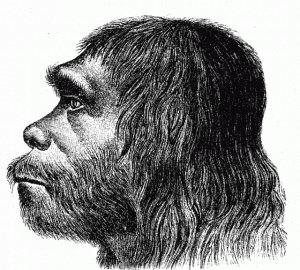Scientific convention used to be that modern humans came out of Africa and completely replaced Neandertals (also spelled “Neanderthals”) without interbreeding (for example, see here). New evidence suggests that this hypothesis is incorrect, according to an article by Ann Gibbons called “Close Encounters of the Prehistoric Kind.” The article appears in the May 7, 2010 edition of Science (available online only to subscribers). An international team has now completed the draft sequence of the Neandertal genome, which includes more than 3 billion nucleotides collected from the bones of three female Neandertals who lived in Croatia more than 38,000 years ago.” The analysis described was astoundingly complex, and the consequences of this analysis are startling:
By comparing this composite Neandertal genome with the complete genomes of five living humans from different parts of the world, researchers found that both Europeans and Asians share 1% to 4% of their nuclear DNA with Neandertals. But Africans do not. This suggests that early modern humans interbred with Neandertals after moderns left Africa, but before they spread into Asia and Europe. The evidence showing interbreeding is “incontrovertible,” says paleoanthropologist John Hawks of the University of Wisconsin, Madison, who was not involved in the work. “There’s no other way you can explain this.”

Therefore, many people living outside of Africa carry “a small but significant amount of DNA from these extinct humans.” The consequences of this amazing finding are not lost on anyone:
In a sense, the Neandertals are then not altogether extinct, says lead author Svante Paabo, a paleogeneticist at the Max Planck Institute for evolutionary anthropology in Leipzig Germany, who is surprised to find out he was part Neanderthal. “They live on in some of us.”
The Science article presents the following list of things we now know about Neanderthals:
- The genomes of modern humans and Neanderthals are 99.84% identical.
- The scientific data don’t support interbreeding when scientists had most expected it (between 45,000 and 30,000 years ago in Europe).
- Neanderthals coexisted with modern humans in Europe from 30,000 to 45,000 years ago, and perhaps in the Middle East as early as 80,000 years ago.
- The amount of admixture is tiny, even among Europeans and Asians, but Neanderthals “are significantly more closely related to non-Africans than Africans on average.
- The new data fits with the discovery of fossils and stone tools from Israel caves about 80,000 years ago (modern humans and Neanderthals both used these caves and had much in common–they used similar tool-kits and under the same animals). One Neandertal skeleton from the Middle East looked “less robust than Neanderthals in Asia and Europe.
- Despite the ability to sequence some Neanderthal DNA, there is no possibility of cloning a Neanderthal.
- “The isolated DNA was in pieces typically about 50 bases long, and there were many missing stretches. Further, despite the story one often hears in the mass media, DNA is not completely responsible for the appearance of an animal. “Chemical modifications to the genome, the way chromosomes arrange in the nucleus, and maternal components in the egg all play a role in translating a genetic blueprint into a viable individual.” None of these are available with regard to Neanderthals. As soon as you substitute another oocyte (e.g., that of a modern human) for that of a Neandertal, you would change the resulting organism.
Despite the fact that there was some interbreeding, it did not happen much. This article quotes evolutionary geneticist Sarah Tishkoff, who asked “Was it a cultural barrier?”
We are cousins with every living thing on planet Earth (including trees and see here), but many of us are both cousins and descendants of Neandertals. Therefore, for those of you who have had ancestors from anywhere outside of Africa (keeping in mind that all of us have ancestors from Africa), you are African and you are Neandertal. I’m planning on having a bit of fun the next time a bureaucratic form requires me to designate my “race.”


DUDE! Look at the picture you use for your "G!" Except for he balding, totally Neandertal!
Man, I'm jealous! Maybe that's where your musical genes came from, eh?
Maybe it was like when we were in high school and some guy comes over to where we're making time with some honeybee and starts playing the guitar; suddenly we're forgotten! But, the spurned non-Neandertal dudes took their revenge and bashed the more musical Neandertal dudes over their heads (perhaps with a guitar!)in a fit of jealous rage thus wiping out the males of the race and leaving only the females to limitedly breed which resulted in us.
Yep, that totally explains why some of us have 1-4% Neandertal genes! The female Neandertal genes would retain their viabilty by being transferred via the mitochondria of their progeny's cells. The reduced percentages may be also explained by the mutations which have occurred over the last 80,000 years, as well the limited numbers of such females after the males were destroyed by jealous non-musical non-Neandertals. It was also likely that copious amounts of alcoholic beverages were involved!
When do I publish? Oh, yeah, just did!